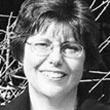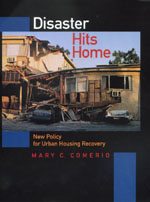
SPECIALIZATIONS
Affordable Housing; Disaster Recovery/Reconstruction; Loss Modeling; Seismic Rehabilitation.
PHILOSOPHY STATEMENT
As an architect working in the realm of earthquake engineering research, I have always tried to bridge the gap between our technical understanding of earthquake (and other disaster) impacts on the built environment, and the social and economic consequences of disaster losses. Architecture is a field in which the diverse understanding of many building issues can be brought together in a creative way.
BIOGRAPHY
Mary Comerio is an internationally recognized expert on disaster recovery. She joined the faculty in the Department of Architecture at UC Berkeley in 1978 and served as chair of the Department from 2006-2009. As an architect, she has designed numerous public and private facilities, including market rate and affordable housing. Her research focuses on the costs and benefits of seismic rehabilitation (particularly housing), post-disaster recovery and reconstruction, and loss modeling. She is the author of Disaster Hits Home: New Policy for Urban Housing Recovery. In 2011, she received the Green Star Award from the United Nations for her work in post-disaster reconstruction in China and Haiti. In 2013, she received the UC Berkeley Chancellor’s Award for Public Service for Research in the Public Interest, and the EERI Distinguished Lecturer Award. She was made an honorary member of the Structural Engineers Association of Northern California and the Earthquake Engineering Research Institute in 2018 and 2019, respectively. She is a past- president of the Earthquake Engineering Research Institute, and is currently on the Governing Board of the QuakeCoRE Center for Earthquake Resilience in New Zealand. In 2019, she was a Visiting Professor at Sapienza, University of Rome in the Department of Structural and Geotechnical Engineering. She consults internationally on disaster recovery and resilience planning.
Comerio led the FEMA-sponsored Disaster Resistant University Program. Her research, together with the UC Berkeley campus seismic rehabilitation program, was recognized by Engineering News Record as one of the ten best seismic-planning projects in the United States in 2006, and by the EERI Northern California Chapter in 2012. Comerio also led the Building Systems Research in the Pacific Earthquake Engineering Research Center, during the ten years when PEER was one of three NSF-funded national earthquake centers. Comerio also served at co-PI on one of the National Science Foundation’s Grand Challenge projects focused on the mitigation of collapse risk in nonductile concrete buildings. Her building inventory and loss-modeling led to the creation of the Los Angeles “Resilience by Design” plan. She led the PEER/EERI reconnaissance teams to several earthquakes in New Zealand and conducted a review of the housing recovery in Chile for the Ministry of Housing and Urban Development and the United Nations Development Program. She has recently served on the steering committee for National Institute of Science and Technology (NIST) Report on “Research Needs to Support Immediate Occupancy Building Performance Following Natural Hazard Events” (NIST SP #1224), and is currently on the FEMA-NIST Steering Committee to develop a report on “Functional Recovery of the Built Environment and Critical Infrastructure”.
COURSES TAUGHT
ARCH 120 Introduction to the Practice of Design
ARCH 128 Architectural Internship
ARCH 253 Architectural Design for Seismic Forces
ARCH 269 Seminar in Construction and Materials
AWARDS & RECOGNITION
Honorary Member, Earthquake Engineering Research Institute, 2019. Visiting Professor, Department of Structural and Geotechnical Engineering, Sapienza, University of Rome, Spring 2019. Honorary Member, Structural Engineers Association of Northern California, in recognition of research and contributions to resilience, 2018. Chancellor’s Public Service Award for Research in the Public Interest. U. C. Berkeley, 2013. Earthquake Engineering Research Institute (EERI) Distinguished Lecturer 2013. Green Star Award (2011) from the United Nations for disaster recovery work in China and Haiti.
Publications
Comerio, M.C., "A Place to Live After the Shaking Stops," The L.A. Earthquake Sourcebook, produced by Richard Koshalek and Mariana Amatullo, Art Center College of Design, Pasadena, CA, 2008, pp. 255-259.
Comerio, M.C., "Estimating Downtime in Loss Modeling," Earthquake Spectra, Vol. 22, No.2, May 2006.
Comerio, M.C., "Can Buildings Be Made Earthquake-Safe?" SCIENCE, Vol. 321, April 14, 2006, pp. 204-206.
Comerio, M.C., "Key Elements in a Comprehensive Theory of Disaster Recovery," 1st International Conference on Urban Disaster Reduction, Institute for Social Safety Science and EERI, Kobe, Japan, 2005.
Comerio, M.C., "Public Policy for Reducing Earthquake Risks: A U.S. Perspective," Building Research and Information, Special Issue on Risk in the Built Environment, Vol. 32 No. 5, September-October 2004, p. 403-413.
Comerio, M.C., "Paying for the Next Big One," Issues in Science and Technology, Vol. XVI, No. 3, Spring 2000, pp. 65-72.
Comerio, M.C., Disaster Hits Home: New Policy for Urban Housing Recovery, University of California Press, Berkeley, 1998.
List of Disaster Resistant University Initiative & Pacific Earthquake Engineering Research Center Publications
Comerio, Mary C., Housing Recovery Lessons from Chile, Journal of the American Planning Association 80:4, 340-250 (2014). DOI: 10.1080/01944363.2014.968188.
Anagnos, T., Comerio, M.C., Goulet, C., May, P., Greene, M., McCormick, D.L., and Bonowitz, D., "Developing Regional Building Inventories: Lessons from the Field," Earthquake Spectra, Vol. 28, No. 4, pp. 1305-1329, November 2012.
Comerio, M.C., and Anagnos, T., "Los Angeles Inventory: Implications for Retrofit Policies for Noductile Concrete Buildings," Proceedings 15WCEE, Lisbon, Portugal, September 2012.
SPUR, "Safe Enough to Stay: What will it take for San Franciscans to be able to shelter in their homes after an earthquake?" The Urbanist, San Francisco Planning and Urban Research, San Francisco, CA, February 2012.
Comerio, M.C., "Rebuilding Safe and Appropriate Housing after Disasters in California and Mexico," Chapter 7, Case Study 2, in Blakely, E., ed., Managing Urban Disaster Recovery: Policy, Planning Concepts and Cases, Crisis Response Publications, Australia, 2011.
Comerio, M.C., and K. Elwood, et. al., "The M 6.3 Christchurch New Zealand Earthquake of February 22, 2011," EERI Special Earthquake Report, EERI, Oakland, CA, May 2011.
DesRoches, R., Comerio, M.C., Eberhard, M., and Mooney, W., and Rix, G.J., "Overview of the 2010 Haiti Earthquake," Earthquake Spectra (DesRoches, R., and Comerio, M.C., guest editors), Vol 27, pp. S 1-21, October 2011.
Comerio, M.C., and Blecher, H.E., "Estimating Downtime from Data on Residential Buildings After the Northridge and Loma Prieta Earthquakes," Earthquake Spectra, Vol. 26, No. 4, November 2010.
Comerio, M.C., et al., "The M 7.1 Darfield (Canterbury), New Zealand Earthquake of September 4, 2010," EERI Special Earthquake Report, EERI, Oakland, CA, November 2010.
Comerio, Mary C., Disaster Recovery and Community Renewal: Housing Approaches, Chapter 1 in Coming Home After Disaster: Multiple Dimensions of Housing Recovery (eds. Alka Sapat and Ann-Margaret Esnard, Routledge, Boca Raton, FL 2017.
Thalia Anagnos, Mary C. Comerio, and Jonathan P. Stewart, Earthquake Loss Estimates and Policy Implications for Nonductile Concrete Buildings in Los Angeles. Earthquake Spectra, 32: 4, 1951-1973 (2016).
Comerio, M.C., "Housing Recovery in Chile: A Qualitative Mid-Program Review," Pacific Earthquake Engineering Research Center, University of California, Berkeley, PEER Report No. 2013/01, February 2013.

